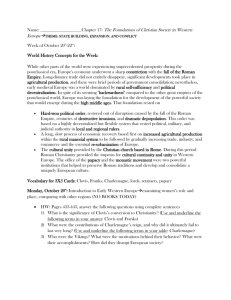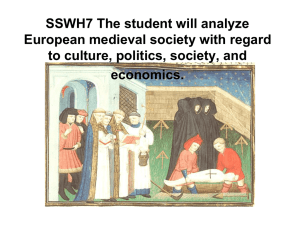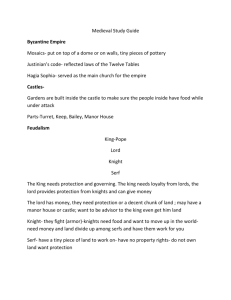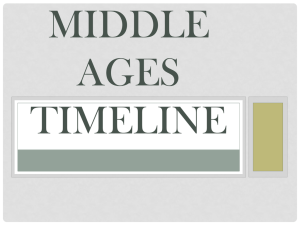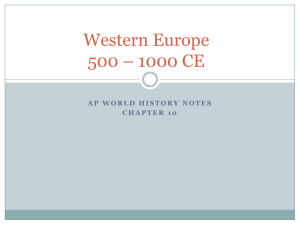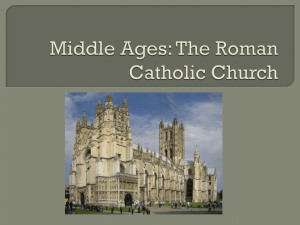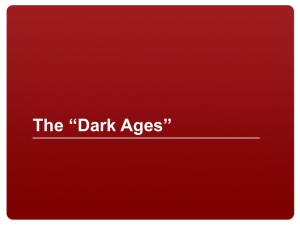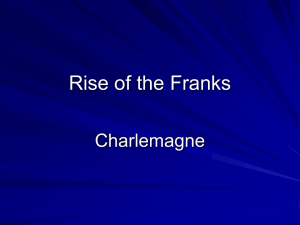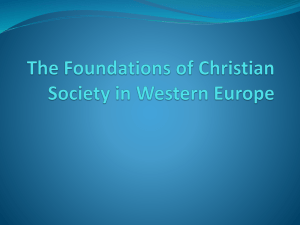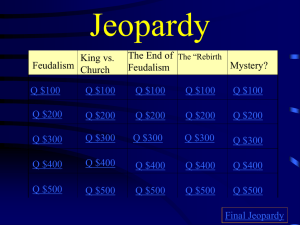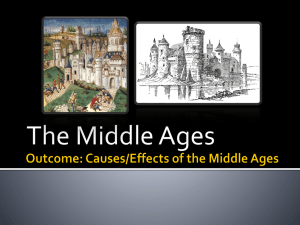A New Civilization Emerges in Western Europe
advertisement
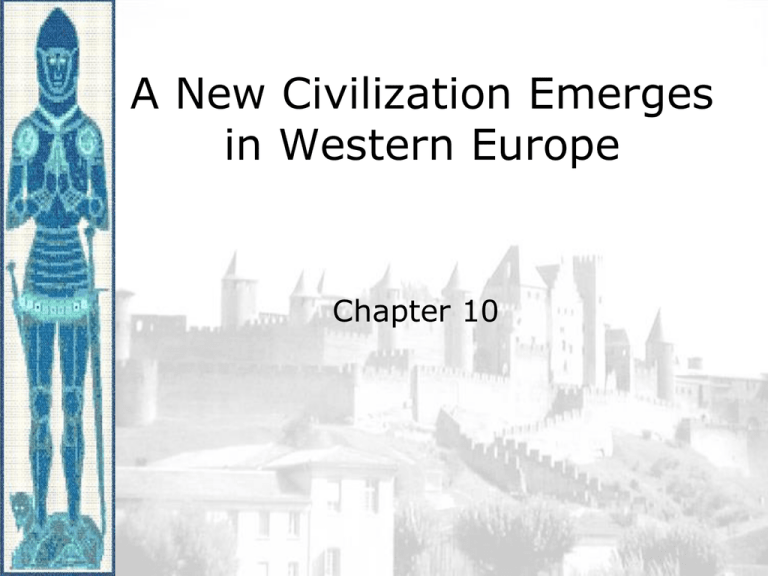
A New Civilization Emerges in Western Europe Chapter 10 The Middle Ages • Postclassical period in western Europe known as the Middle Ages, stretches between the fall of the Roman Empire (476 CE) to the mid-15th c. • Christian missionaries converted Europeans from polytheistic faiths to monotheistic ones (mainly Christianity) – Cultural Diffusion • New tools and crops expanded agricultural output; advanced technologies improved manufacturing • Effective political and military power in Europe was localized w/ regional aristocrats Periodization Early Middle Ages: 500 – 1000 High Middle Ages: 1000 – 1250 Late Middle Ages: 1250 - 1500 •Western Europe not as commercially or culturally developed as the great world civilizations Europe in the 6th century •Europeans long lived under the threat of incursions from the stronger Islamic world and other invaders •The Catholic Church in the first centuries after 500 was the single example of a firm organization. People value religion above everything else •Vikings – Seagoing Scandinavian raiders who disrupted coastal areas of Europe from the 8th to 11th centuries; pushed across the Atlantic to Iceland, Greenland, and North America •From the mid-5th c. until about 900 CE disorder prevailed in western Europe •Muslims controlled Spain - maintained a vibrant intellectual and economic life •The pope headed a hierarchy based on the Roman imperial model; they appointed some bishops, regulated doctrine, and sponsored missionary activity •The conversion of Germanic kings, such as Clovis of the Franks demonstrated the spiritual and political power of the church The Medieval Catholic Church filled the power vacuum left from the collapse of the classical world. provided schools for the children of the upper class. provided inns, hospitals, & refuge in times of war. The Power of the Medieval Church played a large part in the feudal system. the church controlled about 1/3 of the land in Western Europe. crusades tithe 1/10 tax on your assets given to the church. Peter’s Pence 1 penny per person [paid by the peasants]. •Scholasticism – Dominant medieval philosophical approach. Name originated because of its base in the schools or universities; based on the use of logic to resolve theological problems •Roman Catholic Church – Church established in western Europe during the Roman empire and the Middle Ages; head of the church is the bishop of Rome (Pope) •Pope – Meaning papa or father; bishop of Rome and head of Catholic church •Thomas Aquinas – Creator of one of the great syntheses of medieval learning; taught at University of Paris; believed that through reason it was possible to know much about natural order, moral law, and the nature of God. Roman Architectural Style Rounded Arches. Thick walls. Dark & simplistic interiors. •Gothic style – An architectural style developed during the Middle Ages in western Europe; featured pointed arches and flying buttresses as external support on main walls; 11th century. •Manorialism – System of economic and political relations between landlords and their peasant laborers. •A manor would include the lord and all the serfs of a village or group of villages, their mutual obligations to provide protection, labor, & justice, for all people in the manor •In return for protection they (serfs) gave lords part of their crops and provided labor services •Feudalism – is a system in which weaker vassals (weaker lords) served stronger nobles (stronger lords), receiving protection in return. Feudalism was a prominent form of government during the Middle Ages •Vassals – Members of the military elite who received land from a lord in return for military service and loyalty •A “manorial system” is a way of living economically and socially, on a large farm, in a self-sufficient manner. •Intellectual activity sharply diminished; most literate individuals were Catholic monks and priests •Serfs bore many burdens, but they were NOT slaves; had heritable ownership of houses and land as long as they met their obligations •Most individuals were serfs living on self-sufficient agricultural estates (manors) Feudalism A political, economic, and social system based on loyalty and military service. Vassal owned loyalty to their lord The Carolingian Renaissance – Dynasty took over the Frankish monarchy in the 8th century •The Carolingian dynasty of the Franks - ruled in France, Belgium, and Germany; grew stronger during the 8th c. •Charlemagne built a substantial empire by 800 CE; he helped to restore church-based education and revived traditions of Roman imperial government •The empire did not survive Charlemagne’s death; his sons divided the territory; the rulers reigning in Germany and northern Italy initially were the strongest •Charlemagne – Carolingian monarch who established a large empire in France and Germany •Holy Roman emperors – Rulers in northern Italy and Germany following the breakup of Charlemagne’s empire; claimed title of emperor but failed to develop centralized monarchy Charles the Great Charlemagne: 742 to 814 Charlemagne’s Empire The Rise of European Monarchies England •Clovis – King of the Franks; converted to Christianity circa 496 •Carolingians –Royal house of the Franks formed during 6th to the 10th c. •Charles Martel – Carolingian monarch of the Franks; defeated Muslims at Tours in 732 Pope Crowned Charlemagne Holy Roman Emperor: Dec. 25, 800 •Western Europe remained politically divided •The Holy Roman Empire’s territories in Germany and Italy were controlled by local lords •The pope ruled in central Italy •King John of England in 1215 was forced to recognize feudal rights in the Magna Charta •Parliament emerges! - Most members of societies were not represented, but the creation of representative bodies was the beginning of a distinctive political process not present in other civilizations Black Death – plague that struck Europe in the 14th c., significantly reduced Europe’s population; affected social structure; Bubonic Plague Carcassonne: A Medieval Castle Parts of a Medieval Castle The Medieval Manor •Peasants wanted more freedom and control of land, while landlords wanted higher revenues •After 800 CE peasant conditions improved and landlord’s control weakened •Moldboard was a technological innovation, a plow that allowed deeper tuning of the soil Manorialism Feudalism Described economic/political relationships between landlords & serfs Relationships between stronger/weaker lords & military elite Serfs received protection and justice form lords in return for labor and portion of produce greater lords provided protection and land to vassals in return for military service and loyalty. •Hundred Years’ War – Conflict between England and France (1338-1453) •Joan of Arc – lead French army to victory •Europe in the “High Middle Ages” (1000 – 1250 CE) Chivalry: A Code of Honor and Behavior Chivalry - Medieval code used by knights which included the ideals of courage, honor, and the protection of the weak William the Conqueror: Battle of Hastings, 1066 •William the Conqueror – Invaded England from Normandy in 1066; established tight feudal system and centralized monarchy in England Evolution of England’s Political System – Achieved feudal monarchy prior to the end of the Middle Ages Henry I: William the Conqueror’s son. set up court system. Henry II: established the principle of common law throughout the kingdom. established a grand jury. established trial by jury. Magna Carta, 1215 King John I the “Great Charter” (nickname) monarchs were NOT above the law kings had to consult a council of advisors kings could not tax arbitrarily The Beginnings of the British Parliament Great Council: middle class merchants, townspeople [burgesses in England, bourgeoisie in France, burghers in Germany] were added at the end of the 13th century. eventually called Parliament. by 1400, two chambers evolved: o House of Lords nobles & clergy. o House of Commons knights and burgesses. Pope Urban II: Preaching a Crusade Pope Urban II - Called the First Crusade in 1095; appealed to Christians to free the Holy Land from Muslim control •1st Crusade – 1096-1099 – Crusade called by Pope Urban II which captured Jerusalem •2nd Crusade – 1147-1149 – Led by French and Germanic Kings. Failed to capture city of Damascus. Only a couple thousand returned home (Turks annihilate Crusaders) •3rd Crusade – 1189-1192 – Crusade led by King Richard the Lionheart to recapture the city of Jerusalem from Islamic forces led by Saladin; failed in attempt •4th Crusade – 1202-1204 – Crusade which attacked and sacked Constantinople Christian Crusades: East and West Comparing Medieval West from 1000-1500 with Islamic civilization during the same time period Medieval West Islam Flourishing Fragmenting Active Commercial and merchant system More extensive and significant commercial system Banking, use of credit, guilds, creation of wealthy class, end of slavery Both used religion to carry civilization to new territories Use of Latin as common language – Classical rationalism based on Aristotle’s works Islam expanded into Africa, north India and southeastern Asia Islamic civilization more technologically sophisticated than the West Oxford University Peter Abelard – author of Yes and No; a university scholar who applied logic to problems of theology; demonstrated logical contradictions within established doctrine St. Bernard of Clairvaux – Emphasized role of faith in preference to logic; stressed importance of union with God; successfully challenged Abelard and had him driven from the universities. His preaching's helped ignite the 2nd Crusade Medieval Trade •Guilds – Associations of workers in the same occupation in a single city; stressed security and mutual control; limited membership, regulated apprenticeship, guaranteed good workmanship, discouraged innovations; often established franchises within cities Medieval Guilds Commercial Monopoly: Controlled membership apprentice journeyman master craftsman Controlled quality of the product [masterpiece]. Controlled prices •Western Europe in the Middle Ages and the world around it: •Early on - Europe threatened by Vikings, Asian nomads, & Islamic expansion •At the same time, Europeans copied many features from Islam and traded with Asians (diffusion!) •Through selective acceptance of benefits from the world around them, Western Europe developed a global awareness •Crises of the later Middle Ages: •bubonic plague •religious struggles •governmental strife Ways in which the Middle Ages carried on the culture of ancient Mediterranean civilizations •Latin as common language •Manorialism – origins in great farming states •Christianity was widely adopted Middle Ages added it’s own innovations: •Population growth •Credit, banking, accounting procedures, creation of a wealthy class •Vernacular literary forms and Gothic architecture Characteristics of feudal monarchy (France and England) England France Immediate after Norman Conquest in 1066 Established central government Slow and gradual Sheriffs as local administrators France responded in 13th c. development of taxation Court system to support military action against England
